
In many wheat fields in the Western Cape the control of early-season aphids with insecticides is a standard practice. In some cases, seed is treated with a systemic insecticidal dressing before planting and in others insecticide is added to the spray tank when herbicides are applied. Is this the best way to control aphids?
The principles
Let us look at some principles that are critically important to keep in mind when considering pest control. Figure 1 shows the crop-pest response curve which illustrates how damage from a pest occurs on a crop over time.
Aphid infestation time is shown from left to right with the pest pressure increasing from the initial infestation (green) to the point where no more damage can be caused (blue) in the graph. The yield expressed as a percentage of the maximum potential progressively declines from 100% as the pest pressure becomes higher. The different colour blocks illustrate distinctly different phases of this interaction between a host crop and the pest that attacks it.
Green block: This part of the graph illustrates what happens when there are zero to very few pests attacking the plant. Plants have inherent defence mechanisms that help them to counteract pests. This means that if the number of insects – also called the pest pressure – is small, the plants compensate for the damage and no yield loss occurs.
Yellow block: This illustrates what happens to the yield as the insect population on the plants increases. In this phase the insects are starting to get the better of the plant’s defence systems. Yield loss has started to happen, but it is not yet equal to the cost of managing the pest. During this phase, the action threshold occurs. This is when corrective action like spraying should be taken to prevent economic loss occurring. Natural enemies, such as entomopathogenic fungi, can also act as ‘corrective action’ and when present in this phase, can replace spraying with insecticides.
Red block: The point where the cost of control is equal to the amount of yield loss is the start of this phase. From then on, economic yield loss occurs at a much faster rate. This means the longer one waits before applying control, the less likely one is to protect the crop yield effectively. If corrective measures are not taken in time, or if they are ineffective, yield loss may not be halted timeously, leading to higher input expense as well as lower income.
Blue block: This represents the phase where no further loss can occur, usually due to the crop becoming unsuitable to host the high numbers of the pest present on it. This often occurs when climatic conditions become unfavourable for that particular pest or when the crop reaches the end of the season and no longer provides what the pest requires from it.
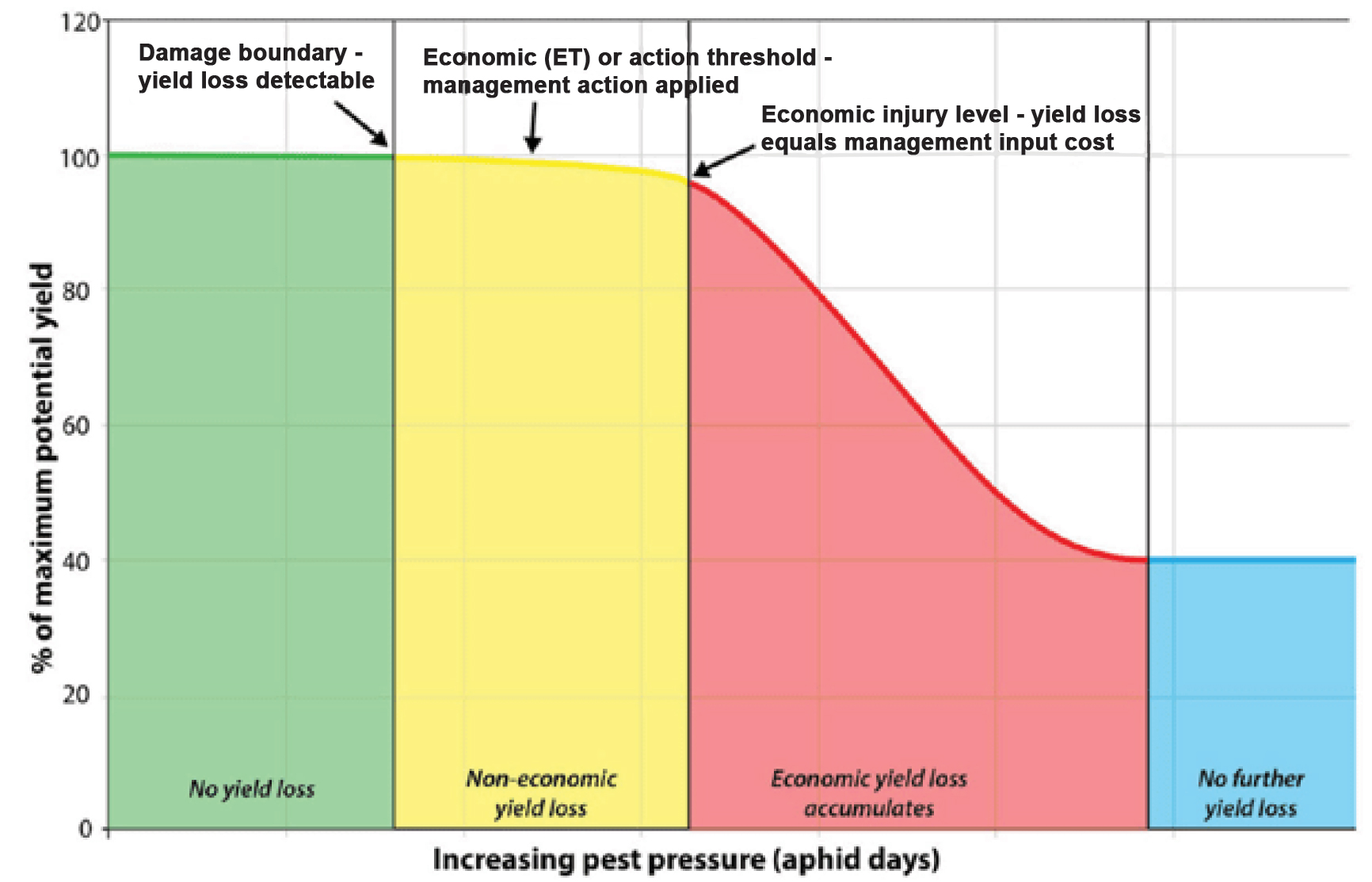
Source: Christian H Krupke, www.researchgate.net. After Pedigo et al., 1986.
Timing is everything
There is a sweet spot where the application of a corrective measure will prevent yield loss and the cost of the control measure will be fully recovered, leaving the producer with maximum profit.
Knowledge is power
One has to know exactly what is happening in the field in order to determine when to apply control. Scout all fields regularly to determine whether it is necessary to apply control measures.
Keep as much balance in the system as possible
Spray programmes, routine seed dressings and precautionary applications of insecticides should be avoided as far as possible. These applications disturb the natural balance within the production system, negatively influencing non-target species and leading to the development of insecticide resistance in the pest populations.
Cultural control practices are beneficial
Making sure that non-crop season hosts of the crop pest, such as volunteer wheat and barley, are kept to a minimum, will assist in keeping the initial infestation of pests in the field lower. Promote patches of diverse habitat that help natural enemies of the pest to multiply so that they are available to attack the pest during the crop season.
Details on small-grain aphids in the Western Cape
There are four different aphid species that occur on small grains in the Western Cape annually: the oat aphid (Rhopalosiphum padi) (Photo 1), the rose-grain aphid (Metopolophium dirhodum) (Photo 2), the English grain aphid (Sitobion avenae) (Photo 3)and the Russian wheat aphid (Diuraphis noxia) (Photo 4).
It is really important to be able to tell the difference between these species as they differ in their ability to cause damage. Research results over many years show that not all four species reach damaging levels every year. There are big differences between seasons too. In some years more than one species can attain pestiferous levels and in other years none do. Often these species can occur simultaneously during a particular season.
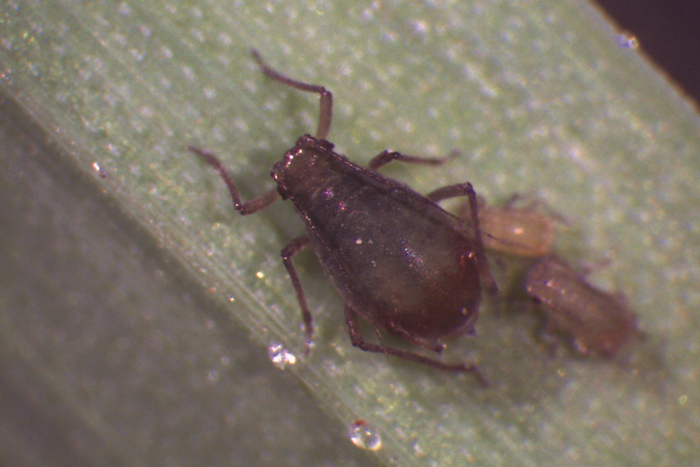
Photo: Vicki Tolmay
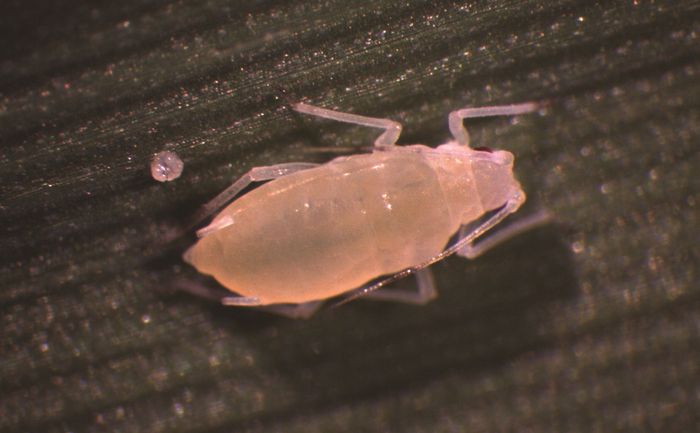
Photo: Goddy Prinsloo
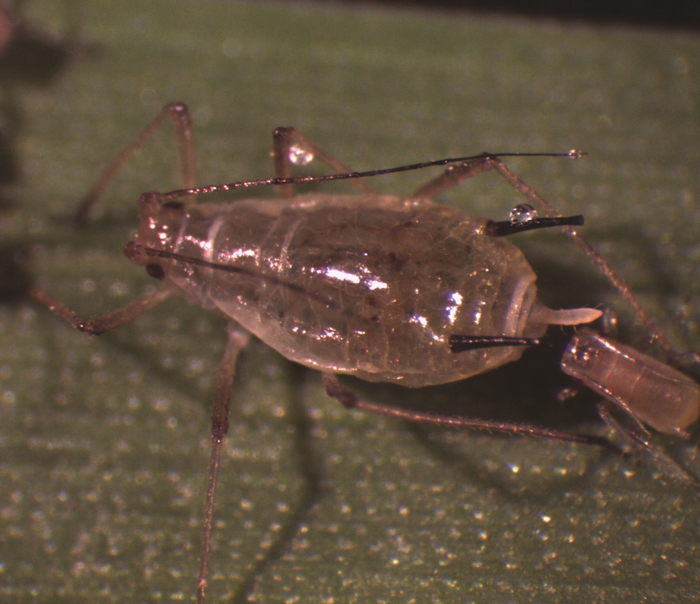
Photo: Goddy Prinsloo
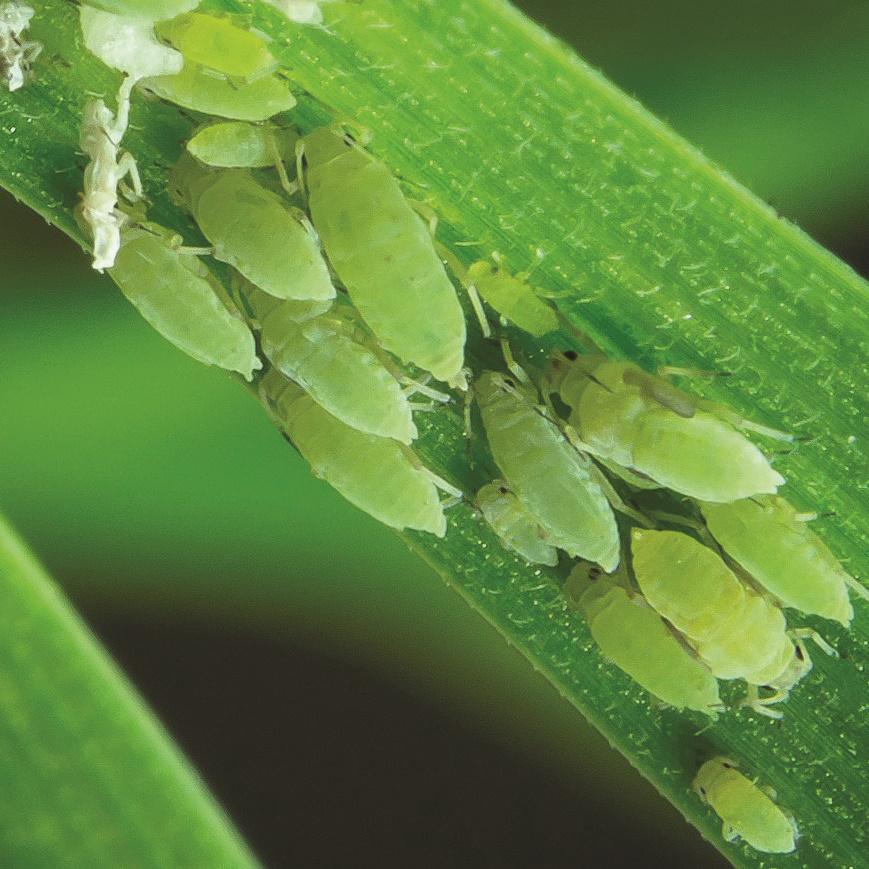
Photo: Kobus Dreyer
Why producers should change the way they control early-season aphids
Aphids are becoming less sensitive to insecticides
Recent research by Dr Astrid Jankielsohn from ARC-Small Grain, shows that wheat aphids in the Western Cape are becoming less sensitive to insecticides, meaning they are developing resistance. Less sensitive aphid populations have been identified for active ingredients of both foliar insecticides and seed dressings.
Weigh the benefits of seed dressings against the disadvantages
This method of control is chosen primarily for convenience and ‘potential’ benefit as a preventative measure. It works well for the duration of the control period, but has significant disadvantages. Firstly, the cost is incurred whether or not the aphids reach damaging population levels. Secondly, by using insecticides to keep the crop aphid-free for the first part of the season, the plant’s natural defence system is prevented from being activated, resulting in a lag before this system kicks in after the seed dressing has stopped working. Additionally, the active ingredient imidacloprid is known to have negative impacts on economically important non-target organisms. Such organisms that are negatively impacted include honeybees, other pollinators and beneficial insects that assist producers with natural pest control and provide valuable ecosystem services.
Apply the registered dosage of any insecticide when population levels of the aphids warrant it
Application of insecticides should be done only when necessary, and under the correct environmental conditions to minimise non-target effects. Careful and well-judged applications, with attention to the rotation of active ingredients, are critical to protect chemical control for future use.
Guidelines for chemical control of aphids
Referring to the action threshold mentioned before: Chemical control is justified between flag leaf and full ear appearance when 20% to 30% of the tillers in a camp are infested with more than ten aphids per tiller. Where different species occur together, the combined number of aphids is used to determine whether the threshold value has been reached. Should the threshold of value above be reached before the above-mentioned growth stage, control can be considered. A second, later application may be required if the action threshold is reached a second time.
 The oat aphid and English grain aphid can both feed on the developing kernels in the ear, but oat aphid is less damaging than English grain aphid in this case. Remember that applications after the flowering stage are not cost-effective. They may stop further damage being caused, but the cost of the application will not be recovered.
The oat aphid and English grain aphid can both feed on the developing kernels in the ear, but oat aphid is less damaging than English grain aphid in this case. Remember that applications after the flowering stage are not cost-effective. They may stop further damage being caused, but the cost of the application will not be recovered.
For more information contact Dr Vicki Tolmay at tolmayv@arc.agric.za or 073 469 0000 (MTN)/072 446 3538 (Vodacom).





























